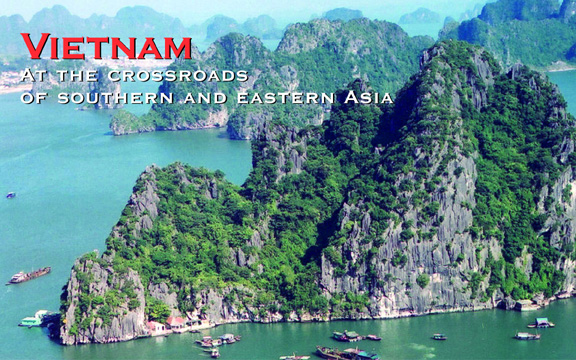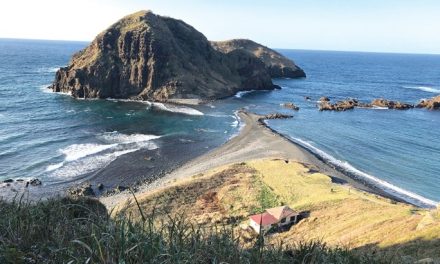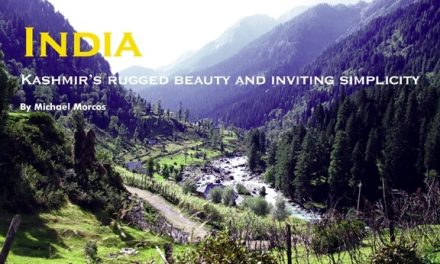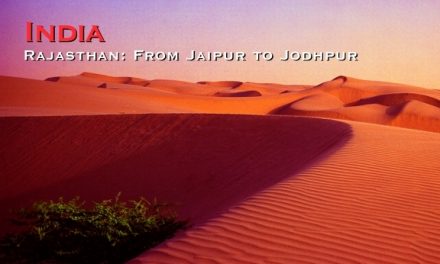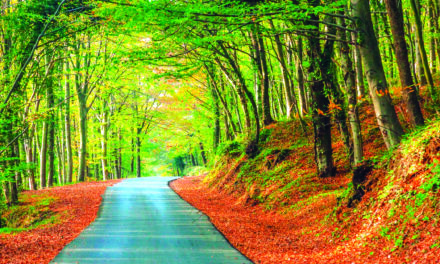Vietnam
At the Crossroads of Southern & Eastern Asia
Published in the Fall 2005 Issue of Canadian World Traveller
Text and Photos: Excerpts from Michelin Green Guide Vietnam (www.viamichelin.com)
Other Photos: Vietnam National Administration of Tourism (www.vietnamtourism.com orwww.vietnamtourism-info.com)
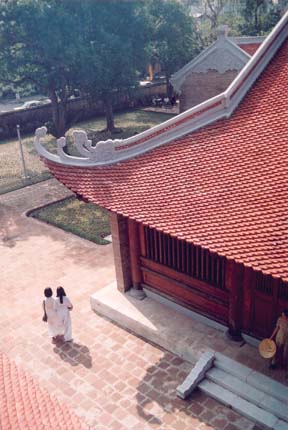 Situated at the crossroads of southern and eastern Asia, on the trade routes between Europe and the Far East, Vietnam hugs the coastline of the South China Sea like a long winding snake. It stretches for 1 650Km from north to south while its width varies from 540Km at the Red River Delta to just 50Km around the town of Da Nang. Wounded by its recent past and subjected to severe demographic pressure, the country is now facing the new challenge of successfully administering its territory and natural resources.
Situated at the crossroads of southern and eastern Asia, on the trade routes between Europe and the Far East, Vietnam hugs the coastline of the South China Sea like a long winding snake. It stretches for 1 650Km from north to south while its width varies from 540Km at the Red River Delta to just 50Km around the town of Da Nang. Wounded by its recent past and subjected to severe demographic pressure, the country is now facing the new challenge of successfully administering its territory and natural resources.
Three Distinct Geographical Zones
The country is divided into three distinct geographical zones, Bac Bo (north), Trung Bo (centre) and Nam Bo (south), that roughly correspond to the administrative divisions set up by the French during the colonial period (Tonkin, Annam and Cochinchina) and together they make up an extraordinary varied landscape.
Transport in Vietnam is an all-important part of the experience of getting to know the country, but you need the time and patience to fully appreciate it. For a brief insight into the northern, central, and southern regions of the country, traveling by car, bus and train, you will need one month. Three weeks should be enough when traveling by plane. Here are two examples of itineraries that take into account one or the other mode of transportation. Both will start in Hanoi.
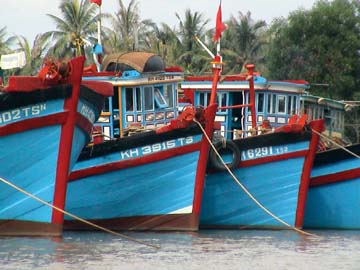 If you have the opportunity, and the chance, to travel for a whole month, following this itinerary will allow you to live Vietnam: Hanoi, Sapa, Ha Long Bay, Hue, Da Nang, Hoi An, Nha Trang, Ho Chi Minh City, Tay Ninh, My Tho, Can Tho and Chau Doc. If you are not on a tight budget, sharing a rented car is the best way to visit the country, making touring much more flexible.
If you have the opportunity, and the chance, to travel for a whole month, following this itinerary will allow you to live Vietnam: Hanoi, Sapa, Ha Long Bay, Hue, Da Nang, Hoi An, Nha Trang, Ho Chi Minh City, Tay Ninh, My Tho, Can Tho and Chau Doc. If you are not on a tight budget, sharing a rented car is the best way to visit the country, making touring much more flexible.
Chauffeur-driven cars are customary in Vietnam and offer the visitor many interesting advantages. As a rough guide, allow US$30 per day for a tour around the Mekong Delta, US$50 in the Central Highlands leaving from Ho Chi Minh City (or US$40 in the region itself), and US$30 in the North of Vietnam. Because of the run-down state of the vehicles and the poor driving conditions, traveling by bus can be a rather grueling not to 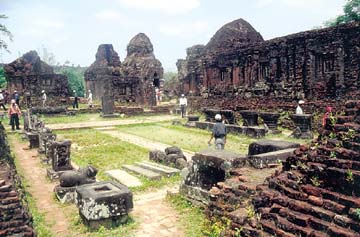 say alarming experience, especially at night.
say alarming experience, especially at night.
The train is preferable when long distances are to be covered. The Reunification Express links Hanoi with Ho Chi Minh City (HCMC). Reservations for comfort-class sleepers should be made 2 or 3 days ahead of time and you should avoid the Ted holiday period. The trip with the S1 Express lasts 32 hours. If you only have 3 weeks or less, flying is faster and less tiring. A flight from Hanoi to HCMC is only around US$95. In this case, this itinerary is more appropriate: Hanoi, Ha Long Bay, Hue, Da Nang, Nha Trang, Hoi An, HCMC and My Tho.
The North
Hanoi
The old royal capital, cultural centre and historic birthplace of the Vietnamese nation, assumed its position once more as head of the reunited country in 1976. Hanoi is made up of seven district (Hoan Kiem, Ba Dinh, Dong Da, Hai ba Trung, Tay Ho, Cau Gi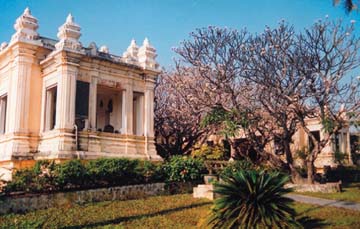 ay and Thanh Zuan) covering an area of 2 146 Km2. But the walking tourist will have less to walk around.
ay and Thanh Zuan) covering an area of 2 146 Km2. But the walking tourist will have less to walk around.
Visitors with a limited time can hire a motorcycle taxi (xe om) or taxi for a quick trip around the main points of interest. Those with more time should explore the city on foot; everything is within walking distance, and visiting museums and pagodas is a perfect excuse for experiencing all aspects of Hanoi life.
Hoan Kien Lake is right in the heart of the city, skirted to the north by the 36 guilds, an area of artisans, craftsmen and small businesses, stretching between the Red River quaysides up to Long Bien Bridge and bordered by the citadel. To the south of the lake, the former French Concession, characterized by the early 20C buildings, corresponds to a line drawn at right angles between the Opera, inspired by Opera Garnier in Paris, and the Cathedral. The northeastern district includes the area of the citadel. Ba Dinh Square is a national symbol surrounded by buildings commemorating Vietnam’s independence (Uncle Ho’s mausoleum).
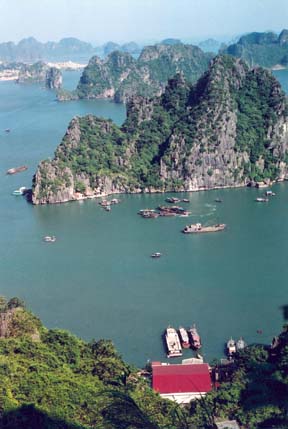 From Hanoi to Ha Long Bay
From Hanoi to Ha Long Bay
This vast region is remarkable for its sceneries. You have Hoa Lu, which was founded amidst a region of limestone hills and peaks with mysteriously disappearing rivers. Nonetheless, for those interested in history or the Viet’s long search for independence, the extraordinary landscape of this region, renamed “inland Halong Bay”, still retains a definite charm.
Halong Bay
There is no doubt that Halong deserved to be designated a World Heritage Site by UNESCO in 1994. There are 1 969 islets rising from the surrounding jade-colored waters, but only 980 have a name. Cruises organized in the bay may appear to be improvised but are in reality designed to take unsuspecting tourists to two particular rock formations, access to which has been specially developed for this purpose. Departures are at Chay Bay at around US$170 for a two day cruise on a deluxe boat.
Sapa
Trekking is one of the main attractions when considering a trip to Sapa. The region’s charm has a lot to do with the terraced rice paddies set out in giant steps mirroring the sky across their flooded expanse. You can stroll at will along the tracks used by the H’mong and the Dao, but you would definitely gain by turning to the services of the local agencies for logistical support. A must, if you can, take the train the Victoria hotels & resorts departing from Hanoi.
The Centre
Hoi An
Declared a World Heritage Site in December 1999 by UNESCO, Hoi an is a genuine living museum, with 844 sites of historic interest, including bridges (Japanese Bridge), wells, pagodas and private houses. It is the city’s unique historic atmosphere, tinged with a hint of nostalgia, that enchants so many tourists as they explore the streets of this seaport from a bygone era.
The town, a no car allowed one, has created a compulsory pass (50 000Vnd) giving access to one museum, one old house, the Japanese Bridge or the Quan Cong Pagoda and one other site of your choice. Also, this is the place if you want to update or renew your wardrobe at a fraction of store costs. Haggling is highly recommended because competition is fierce.
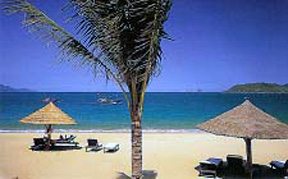 Nha Trang
Nha Trang
The high midday sun engulfs the town in a sluggish indolence. The pristine beach is practically deserted at this time of the day. But come 4 P.M., the town slowly awakens and little by little the promenade along the seafront fills with Vietnamese of all ages. Nha Trang is a town to relax in, with little to do other than enjoy the pleasures of its spotless beach and turquoise sea.
If a day on the beach doesn’t tempt you and you are keen to get out of Nha Trang for a while, why not explore the Cham Towers at Po Nagar or go for a walk along the coast and enjoy the wonderful view of the bay. But, it is very hard to leave one of the most, if not the most, beautiful beach in the world where the water is so clear that you can observe the transparent fish swimming around you.
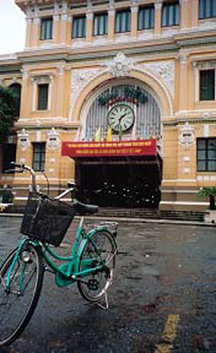 The South
The South
Ho Chi Minh City
The names of Ho Chi Minh City and Saigon both conjure up different sides of the split personality of South Vietnam’s legendary metropolis. Each facet of the city represents an epochal reality, from the pagodas and temples of timeless Vietnam to the elegant buildings of the French colonial era.
Ho Chi Minh City has retained several impressive buildings from the French era, and a restrained approach to urban development, which is singularly uncommon in Southeast Asia. Wandering through these stylish streets swarming with two-wheel vehicles and losing one’s way in the little alleyways can be a real treat. Do not miss the occasion to stroll through the old colonial area, a boat trip on the river, the museums, a walk in Chinatown (Cholon), and a visit at the Ben Thanh Market where all wishes come true, shopping-wise.
My Tho and Mekon Delta
My Tho is an industrious and prosperous city that has retained some attractive riverbank houses from the French colonial period, as well as an appealing Chinese quarter.
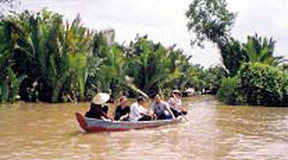 Above all, the city is a starting point for a very pleasant trip to the island fruit orchards, a first taste of the lavish landscapes of the delta that attract an ever increasing number of tourists.
Above all, the city is a starting point for a very pleasant trip to the island fruit orchards, a first taste of the lavish landscapes of the delta that attract an ever increasing number of tourists.
For More Info:
Vietnam National Administration of Tourism
(www.vietnamtourism.com or www.vietnamtourism-info.com)
Michelin Green Guide to Vietnam
(www.viamichelin.com) available at select travel agencies.
.

